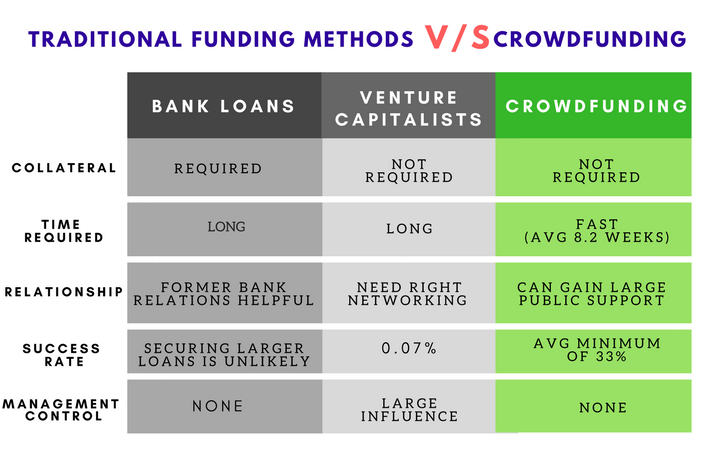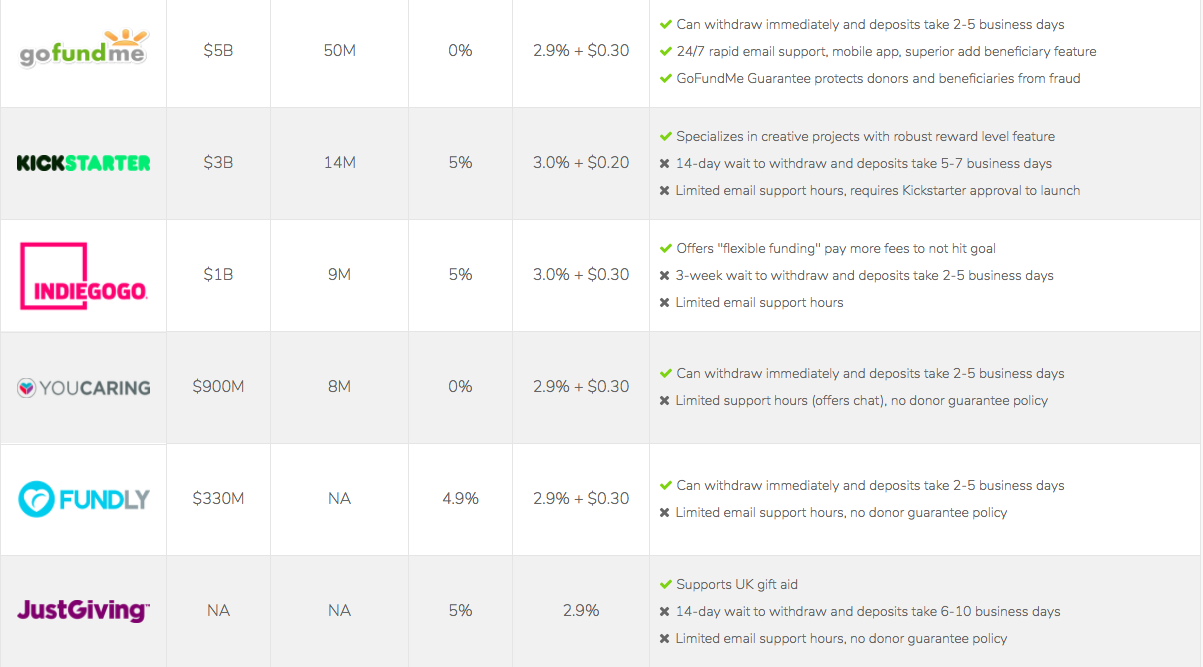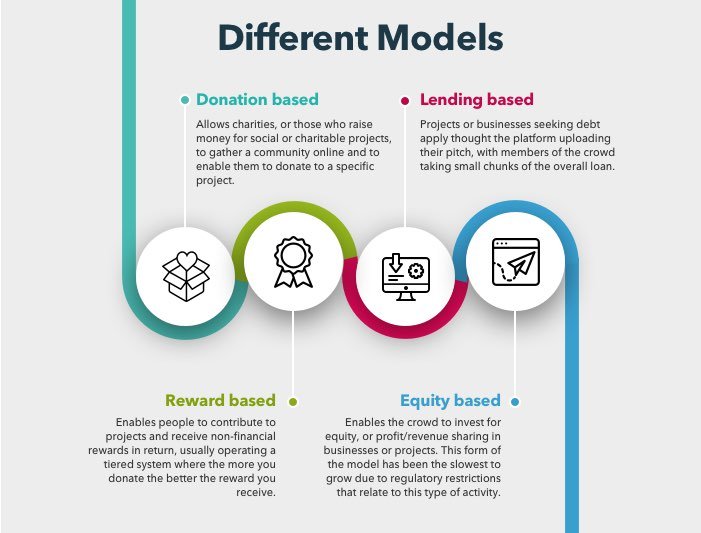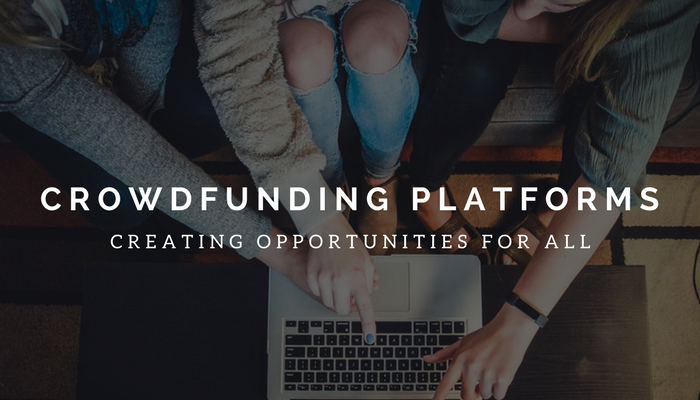What is Crowdfunding?
Crowdfunding is the practice of financing a project by raising capital from a group of people, with the help of the internet. It is a form of crowd-sourcing, and alternate funding for people who do not have the means to raise money for ventures that they want to undertake. There have been several precursors to the model that is currently in use today- mail order subscriptions, offline fundraising events, and other events- but as the internet has evolved, people have found different uses for it; it enables people to reach out to a wider audience through various crowdfunding platforms that are currently operating. Crowdfunding has been used for non-profit projects like raising money for refugee crises, environmental issues, community based issues and several other causes. It is also a platform to raise money for personal projects like artistic pursuits, medical expenses, travel, business ventures, etc. There are more than 600 crowdfunding platforms globally that raise over billions of dollars annually.

The Business Model Of Crowdfunding Platforms
Crowdfunding platforms bring people together; they make use of a network of a vast number of people to with certain interests and enable them to contribute to a cause of project that they believe in. It has the potential to increase entrepreneurship by expanding the pool of investors from whom funds can be raised beyond the traditional sources of owners, relatives and venture capitalists. Crowdfunding platforms have created an opportunity for entrepreneurs to raise hundreds of thousands or millions of dollars from anyone with money to invest in nothing more than an idea. These platforms provide a forum to anyone with an idea to pitch it in front of waiting investors, and open the doors for many more opportunities. Investors (strangers essentially) can visit these websites and go through hundreds of projects to invest in the ones that they like. There is no minimum amount to the amount that you can invest and more often than not, all contributions are rewarded based on the amount that you spend.
The Revenue Generation
Crowdfunding websites generate revenue from a percentage of funds raised. Sites like Kickstarter- which is the most popular and synonymous with crowdfunding- Indiegogo and GoFundMe are some of the most visited crowdfunding platforms on the internet. Since Kickstarter’s founding in 2009, over 130,000 projects have been successfully funded on the crowdfunding website, with more than 3.5 billion dollars pledged for various causes. Indiegogo originally started off as a platform to fund independent films, but eventually expanded and accepted projects for any category a year after its launch, in 2008.
Indiegogo is seen as a less strict and more flexible platform than Kickstarter, as it gives people the option to choose between fixed or flexible models; this is probably the biggest difference between the two popular crowdfunding platforms. Kickstarter releases funds only after the campaign has reached its funding goal, whereas Indiegogo provides the campaigner the opportunity between receiving funding as it comes or choosing to wait until he or she hits his or her target. Furthermore, social media is a powerful tool to help your project reach a wider audience.
Crowdfunding platforms, for a certain fee, will promote your project on their pages to help reach a wider base.
In addition, people who believe in your product, or ones that are personally invested in the same, have the option of sharing it with their circle and improving its reach exponentially. There are PR firms that work specifically to promote crowdfunding projects in places that they know will work and these have been found to be more successful because they have a larger audience that they can reach, compared to that of an individual’s. With the rate at which technology is growing, crowdfunding is sure to change the way capital is raised for various ventures, whether personal or business. Studies show that in the next couple of years, it could grow to be a 300 billion dollar industry.

Examples of SuccessfulVentures
Businesses and products that would have otherwise not been capable of raising capital have been the most successful on crowdfunding platforms; many of the products and businesses crowdfunded on Kickstarter became very lucrative endeavors.

Oculus VR, the American company that specializes in virtual reality hardware and software products, was funded and launched through the site in 2012, when the founder Palmer Luckey created a Kickstarter campaign to raise money to make virtual reality headsets that were designed for video gaming, available to developers. The campaign collected over $2.4 million dollars, which was ten times the original goal of $250,000- and was an amount that was raised unimaginably fast. If this wasn’t enough of a success story, Oculus VR was acquired by Facebook in March 2014, for $2.3 billion in cash and stock.
The smartwatch, Pebble, made the tech industry take notice when it received over $2.6 million after only three days of active crowdfunding on Kickstarter. The project eventually raised 12 million dollars and was backed by over 65,000 backers who were excited for the smartwatch to hit the market. In 2015 again, they raised over 20 million dollars, backed by over 78,000 people. It ranks as one of the most successful campaigns of all time, and was acquired by FitBit in 2016 for 23 million dollars.
Another example of a company that rose to success through the help of Kickstarter campaigns is M3D, a company founded by two friends that manufactures small 3D printers, David Jones and Michael Armani. They raised over $3.4 million for their Micro 3D printer on the crowdfunding site in 2014, which comes with a variety of durable 3D inks to go along with it. It is now available at giants like Staples and Amazon,among other. The company has sales ranging between $10 and $15 million.
Benefits Of Being An Investor
Many crowdfunding projects are rewards-based; investors may get to participate in the launch of a new product or receive a gift for their investment, for as little as a contribution of 10 dollars. Crowdfunding provides another strategy for startups or early stage companies that are ready to take it to the next level – such as rolling out a product or service- but do not have the capital to do so. It has changed the way investing is understood; earlier, a business owner was subject to the whims and fancies of individual angel investors or bank loan officers, often having to compromise on business ideals to fulfill promises that were made at the time of investing. Now it is possible to pitch a business plan to the masses through crowdfunding websites. A successful crowdfunding campaign not only provides your business with much needed capital, but also creates a base of customers who feel as though they have a stake in the business’ success. It also makes for valuable PR; if multiple people are invested in a product, chances are that they will share news that pertains to it, thereby making this information available to more people.
For instance, new video games are a popular crowdfunding investment for gamers, who are rewarded with advance copies of the game and have a sense of contribution to an activity that they are passionate about. Equity-based crowdfunding is growing in popularity because it allows startup companies to raise money without giving up control to venture capital investors, and it offers investors, no matter how small the capital, the opportunity to earn an equity position in the venture. In addition to equity and rewards-based crowdfunding, there are other models as well: marketplace, peer-to-peer and donation based. Donation based is often used for philanthropic endeavours and is not a suggested model when trying to raise funds for a business because it doesn’t offer anything for the investor, and might result in the project not reaching its goal.

Bottomline
Crowdfunding is still new, and has the ability to make businesses in a way that has never been seen before. With technology changing and evolving at a rapid pace, we have probably not even scratched the tip of the iceberg with regards to how this can change business models. It changes the game by allowing more people to have a stake in the product, which can also redefine ownership, in the new digital age.







Great Article!
I loved as much as you’ll receive carried out right here. The sketch is tasteful, your authored material stylish.
Hi, just wanted to say, I loved this article. It was inspiring.
Keep on posting!
Quality articles is the important to be a focus for the users to go to
see the web site, that’s what this web page is providing.
Ahaa, its good dialogue about this post here at this blog, I have read
all that, so at this time me also commenting at this place.
Excellent post. I was checking constantly this weblog and I’m inspired!
Very useful information specially the last part 🙂 I
take care of such info much. I was looking for this particular
information for a very lengthy time. Thanks and best of luck.